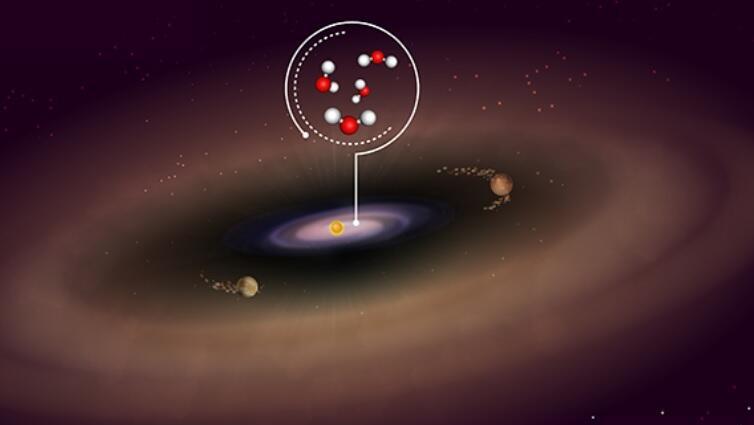PDS 70 is a young sun approximately 5 million years old and slightly smaller than our Sun. Situated about 370 light years away from us, this sun, which is still surrounded by a disk of dust and gas, which are the remnants of the matter from which it was formed. These types of disks serve as the birthplaces of planets, and within this particular disk, two planets are already in the process of formation. Researchers believe that rocky planets, like Earth, are expected to form in the inner region of the disc, closer to the star. A new study found that the disk in this area also contains water, which could potentially allow for the formation of conditions for life similar to ours on these forming planets.
Read more:
The Genesis of Water
Water is a vital component of life on Earth, but the fundamental question - where did the water on our planet come from? - still lacks a clear answer. Some research points to the possibility that comets, and mainly asteroids, that collided with the young Earth are the source of the majority of our water. Other studies propose that the water did not come from an external source, but originated here through chemical reactions between oxygen and hydrogen. The new discovery by an international team of scientists using the James Webb Space Telescope, suggests another possibility: water might have been present here even before Earth came into existence. “We now may have found evidence [that] water could also serve as one of the initial ingredients of rocky planets and be available at birth,” said Giulia Perotti, from the Max Planck Institute for Astronomy (MPIA) in Heidelberg, Germany, the lead author of the research paper.
2 View gallery


Findings that may guide researchers to places where life similar to ours could potentially exist
(Photo: Adriana-Manrique-Gutierrez, NASA)
The researchers from the Max Planck Institute are part of a collaboration called MINDS, in which scientists from 11 European countries use the space telescope's observatory devices to measure mid-infrared radiation in order to decipher the chemical composition of the gas and dust disk around young stars. This discovery marks the first time water has been detected around a star of such age, in the form of vapors at a temperature of approximately 330 degrees Celsius. Previous studies did not find water in these areas, but the new discovery suggests that certain rocky planets may form within an environment already containing a key ingredient for life, at least as we know it.
As noted, two giant gas planets, PDS 70b and PDS 70c - resembling Jupiter and Saturn, are already forming around PDS 70. The disk around their orbits contains much less gas and dust, corroborating the idea that they formed through the accretion of surrounding materials. In the area closer to the star itself, researchers expect the emergence of rocky planets, much like our solar system - having four relatively small terrestrial planets in the inner region, and gas and ice giants in the outer parts. If these do indeed develop within an environment that already contains water vapor, this could explain the source of water on planets like Earth, and also guide researchers to a more focused search of stars that may have planets suitable for life as we know it.
2 View gallery


It is possible that rocky planets are formed in an environment that already contains water vapors. A simulation of the PDS 70 system with the two planets and the inner region where rocky planets are expected to form
(Photo: MPIA)
Combination of Mechanisms
There exist water-abundant clouds, with many of their dust particles enveloped in ice. In light of the surprising discovery of water in the vicinity of the star itself, researchers sought to understand its origin. One possible explanation is that the water is a remnant of the gas and dust cloud from which the star formed. There exist water-rich clouds, with many of their dust particles covered in ice. The radiation emitted by a newly formed star breaks down water into hydrogen and oxygen.
However, in regions dense with dust, some of the radiation is obstructed, preventing the complete decomposition of all water molecules. Another explanation is that the star's gravity draws matter from the edges of its disk, and this matter could potentially contain ice, or oxygen and hydrogen, which could then combine to form water near the star. “The truth probably lies in a combination of all those options,” says Perotti. “Still, it is likely that one mechanism plays a decisive role in sustaining the water reservoir of the PDS 70 disk. The future task will be to find out which one it is.”
To gain a more comprehensive understanding, the researchers plan to carry out further observations with the James Webb telescope. They have also scheduled observations from several large ground-based telescopes, in order to measure various aspects of this system and to search for exoplanets within the water-rich area around the star. The giant telescopes that are set to commence operations by the end of the decade are also expected to contribute to this task.

